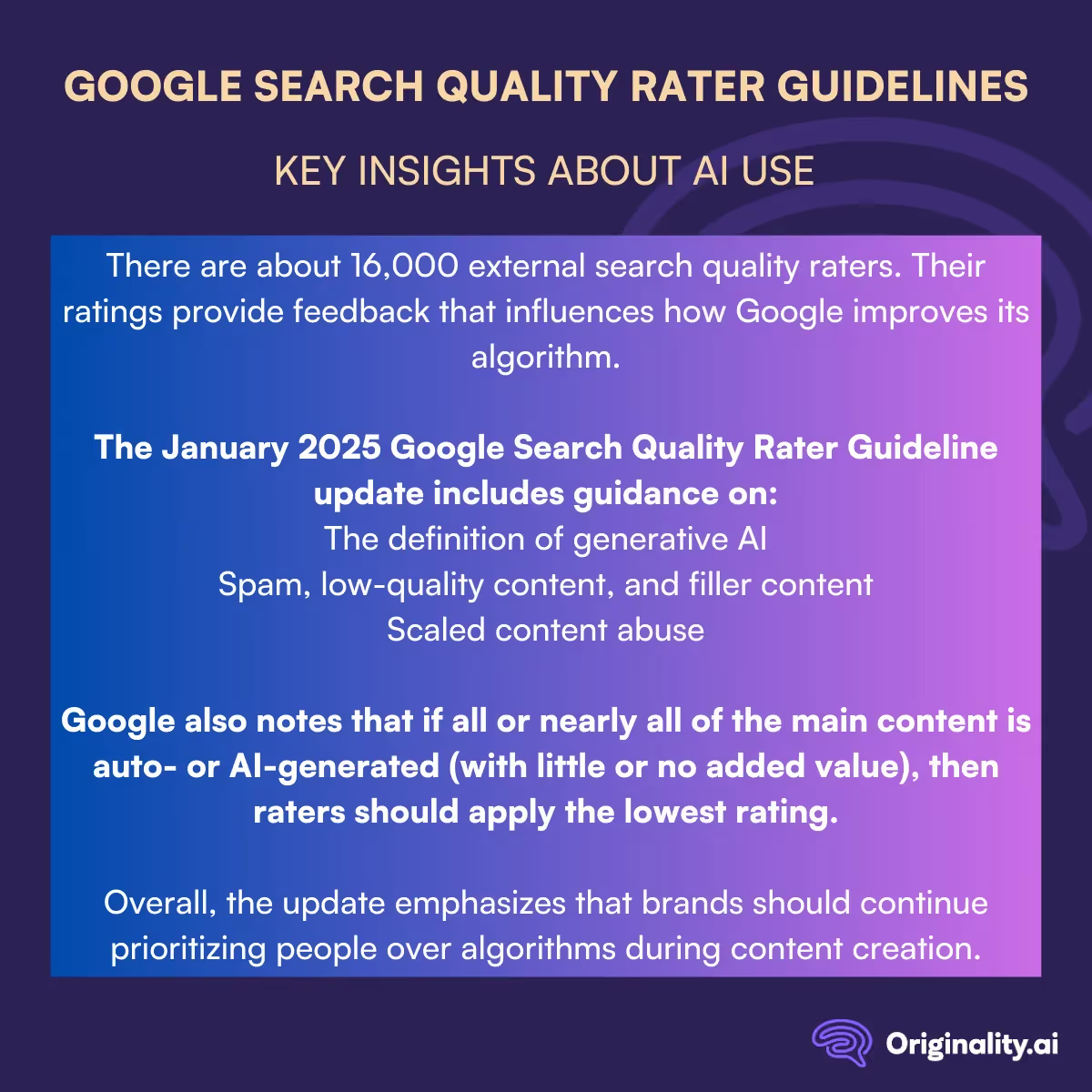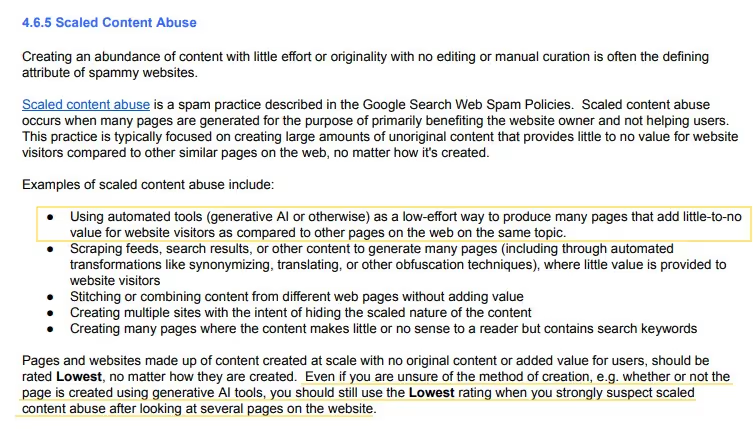With the January 2025 update to the Google Search Quality Rater Guidelines, Google is directing quality raters to look for low-quality generative AI content and is working harder than ever to ensure the best results reach the top of the SERP.
But what are the Google Search Quality Rater guidelines, and how do they tackle AI usage?
Here, we will break down the guidelines in more detail, so you can stay up to date with the 2025 guidelines and continue to outperform your competition.

Maintain transparency and publish your content with confidence. Check out Originality.ai’s AI Checker and Site Scan.
Firstly, before we dive into Google’s recent updates to its Search Quality Rater guidelines, let’s quickly explain what they are.
The Google Search Quality Rater Guidelines are a set of instructions Google has in place for its human evaluators, allowing them to assess and score search results.
In 2020, Google noted that there were more than 10,000 people across the globe working as search quality raters. According to Google’s Search Quality Rater Guidelines Overview, dated November 2023, this number has since risen to approximately 16,000 external search quality raters.
Now, it’s important to note that the human raters can’t directly affect rankings in the SERP. However, they can offer feedback that impacts the Google algorithm.
Google describes these ratings as a “data point that, when taken in aggregate, helps us measure how well our systems are working to deliver great content…” Google further notes that they have conducted 719,326 search quality tests.
So, while the ratings may not directly change a ranking, what ratings can do is influence how Google decides to improve the algorithm.
The guidelines themselves are tailored to focus heavily on E-E-A-T signals, content quality, and relevancy, allowing raters to establish whether or not a chosen page meets a reader’s requirements.
In January of 2025, Google made some significant updates to its Search Quality Rater Guidelines.
We’ve curated some of the top highlights to pay attention to in the updated guidelines from the context of spam and generative AI content:
One of the biggest highlights of this update is the definition and guidance around AI-generated content.
In the guidelines, Google refers to generative AI as a ‘useful tool’, but also highlights that bad actors could potentially misuse its capabilities.
“Generative AI can be a helpful tool for content creation, but like any tool, it can also be misused.” - Google (Section 2.1, Important Definitions)
It’s clear from this language that Google is aware of the many benefits of generative AI. For instance, AI for copywriters can be beneficial for planning, keyword research, and content ideation.
However, generative AI can also be overly relied on, resulting in mass content production where quality takes a back seat — posing clear problems for Google’s people-first content approach that values high-quality and relevant content with unique insights or research.
Alongside highlighting the potential misuse of generative AI in its documentation, Search Engine Journal, which also reported on the guidelines updates, noted that Google has also updated its spam definitions.
In particular, it focused on updates around section 4.0 (Lowest Quality Pages) and 4.6 (Spammy Webpages) with additional subsections and more focus on the ramifications of producing low-effort content.
In the context of generative AI, Google notes that scaled content abuse may include:.
“Using automated tools (generative AI or otherwise) as a low-effort way to produce many pages that add little-to-no value for website visitors as compared to other pages on the web on the same topic.” Google (Section 4.6.5, Scaled Content Abuse)
This key insight here is that if a search quality rater finds that a website is misusing AI to scale and create high quantities of low-effort and low-value content, then the rater should classify it as the ‘lowest’ quality.

Further, in the next section (4.6.6), Google adds that “The Lowest rating applies if all or almost all of the MC on the page (including text, images, audio, videos, etc) is copied, paraphrased, embedded, auto or AI generated or reposted from other sources with little to no effort, little to no originality, and little to no added value…”
Meaning that if a rater finds that the majority of the main content on a page is created with AI and no additional value, insight, or original concepts have been added, the rater should mark that content with the ‘lowest’ rating.

This update falls in line with the major search engine changes we saw from the company back in 2024 that shook the content marketing world. Learn more in our study on Google’s Penalties for AI Content.
This change in language and clear increased focus on low-quality content should come as a warning to any brands that find themselves relying too heavily on AI for content creation.
For anyone who is worried about the presence of AI content on their website, we recommend checking out the Originality.ai Site Scan to identify potential instances of AI-generated content.
One common issue that often occurs when using generative AI tools is that they tend to produce very wordy content that is full of filler and lacks substance.
There is now a specific section within the rater guidelines that addresses filler content, which states:
“Filler can artificially inflate content, creating a page that appears rich but lacks content website visitors find valuable.” - Google (5.2.2, Filler as a Poor User Experience)
Prioritizing high-quality content with innovative insights, stats, and research, which is written for people, is a must.
Get a best-in-class suite of patented content quality tools from Originality.ai, including an AI checker, plagiarism detector, and predictive SEO tool that rewards genuine content improvements.
Overall, Google’s updated Search Quality Rater Guidelines are designed to give their human raters a clearer perspective on the use of AI-generated content, spam or low-quality content, and filler content.
Google notes that generative AI is “a helpful tool for content creation,” acknowledging that it can be a useful part of publishing content. However, the caveat is that AI does have the potential to be misused, like other tools.
As such, Google emphasizes that if raters are reviewing scaled content that is filler or adds little to no value (such as content created by AI tools), then raters should mark it as the ‘lowest quality.’ Additionally, if the majority of a page’s main content is auto- or AI-generated and original or unique value has not been added, then it should also be given the ‘lowest’ rating.
Ultimately, brands should continue focusing on creating great content for users first.
Ready to check if there’s AI content present on your website? Check out the Originality.ai Site Scan or AI Checker today.
Google uses artificial intelligence to better understand search queries, improve the results it presents, and support additional features like AI Overviews.
Yes, Google is evolving Search to become more conversational and interactive. Consider the release of features like AI Overviews, as AI search allows users to get more context-aware answers rather than a list of links, like in traditional search.

The quality and relevance of the content on your website can make or break its success. With fierce competition, you need a tool that helps you stay ahead of the game and ensure your content is top–notch. Stay ahead of the competition with On–Page.ai AI Content Detection, a powerful tool designed to ensure your website
When comparing Rytr to other AI content generation tools, it won’t take long for you to realize that it lacks almost all the features that its competitors do. As a result, it certainly isn’t the best option for marketing or AI experts looking for a detailed tool with plenty of additional capabilities. However, while Rytr’s offering is very basic, what it does do, it does very well. It is a solid AI generation tool, and the addition of an image generation tool is a nice touch. If you are new to AI content generation, Rytr can be a solid jumping-off point for beginners, but quickly you will realize the capabilities of other tools and will likely choose to move on.